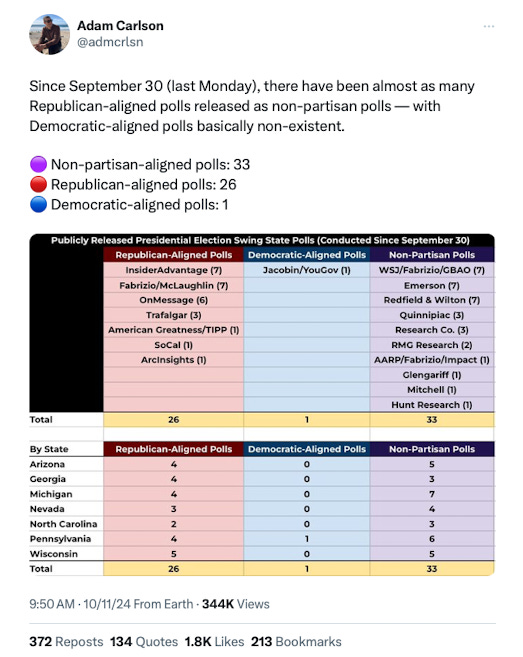So...who is winning?
A simple question with a complicated answer.
Happy Friday my habibis. Things have been heavy over the past few weeks, so let’s take a deep breath and relax. We can get really silly, talk about polls, and maybe even learn about a new cocktail. D.J., get my intro music ready and let’s do this.
Please tell me who is going to win.
In the immortal words of Beyoncé, hold up. I feel like I have included this disclaimer about polls multiple times since 2020, but I’m going to include it anyway: I am increasingly skeptical of their perceived utility in our current political environment. I feel this way for a few reasons:
I am bad at math and have contempt for anyone who is good at it. That also means you should take my entire analysis with a grain of salt. I can write about legal stuff, but this is so far outside of my wheelhouse it might as well be in the ocean (unless there are wheelhouses in the ocean).
I think COVID and/or Apple fundamentally changed the way people answer their phones, making certain groups less likely to pick up calls from random numbers they do not know. So many things now are marked “potential spam,” that it is harder for pollsters to get in touch with regular voters. I think there was a piece in the New York Times from last year that said pollsters have to spend two hours calling random numbers to reach a single person. Picture it: A room full of people, dialing a million numbers, and it takes them two hours to speak to one person! Bonkers. Pollsters are great, professional people who can deal with these limitations, but it still sounds crazy to simple folks like myself.
The polls have been off lately (see: 2022,1 but also special elections this year and last year).
The polling guys are naturally going to tell you that things are OK because they are incentivized to do so.
Polling can be manipulated.
My last point is pretty crucial. Look at this tweet:
To be clear, the same thing happened in 2022: GOP pollsters “flooded the zone” with favorable polls and a media narrative emerged that a Red Wave™ was forming. So, we’ll look at all the averages today, but keep all of this in your back pocket. Things look close on the surface, but under the hood other stuff is going on.
OK, now tell me who is going to win.
We can just look at the averages if you want a quick view of things:
We don’t actually have to spend a lot of time on national polls because they show Harris up:2
But everyone knows the swing states are where the contest is, and they show a tighter race:
Still, if you took the averages to be exactly right, things would work out for a Harris win. Here is what the Electoral College looks like on Election Night 2024 if the averages hold:
All in all, it’s a Harris win. Maybe it’s not a blowout, but it is a simple, solid victory.
Yes, but the polls always underestimate Trump.
I hear you. So do other people. Here is Andrew Sullivan, explaining why he thinks Trump is winning:
Run the numbers on Harris and you can begin to realize why smart Democrats are browning their whites. Today, Harris has a lead of just 2.6 percent nationally — much weaker than Clinton and Biden at this point. It’s the same in the swing states. Cillizza notes that in Pennsylvania at this point, Biden was +7 and Harris is barely +1; in Michigan, Biden was + 8, and Harris is tied. If the polls underestimated Trump's national support by 2.5 points in 2016 and by 4 points in 2020, and the skew continues, then we could well be looking at the first victory in the popular vote that Trump has ever won. More to the point, nothing is really shifting. If anything, there’s a slight drift back toward Trump right now.
I have a weakness in my heart for Andrew, but this is bad analysis (and that’s before he links to Chris Cillizza non-ironically). I’ll explain why.
First off, it is not true that the polls always underestimate Trump and that we have to apply the polling errors of 2020 to 2024. In fact, we have recent evidence that shows they have been overestimating him. In the GOP primaries of early 2024, Trump underperformed his polls in nearly every contest. And even when those primaries were essentially over, Nikki Haley was still capturing tens of thousands of votes.
Second, there are a few things happening under the hood of the polling industry that make me personally think the polls are underestimating Harris’s support. Basically, the pollsters are afraid - deathly so - of producing another error that fails to predict Trump’s win. They underestimated Trump in 2016 and then somehow did even worse in 2020. If they did it again in 2024, it would lead to a huge collapse of trust in the polling industry.
However, if they did a similar oopsie and underestimated Harris? That’s probably not as big of a deal. They’d even had a good excuse, which was that they wanted to make sure Trump voters were reflected in polls, and maybe overcorrected. Nate Cohn over at the New York Times explains this:
[Pollsters] use a statistical technique called weighting, in which pollsters give more or less “weight” to respondents from different demographic groups, such that each group represents its actual share of the population. In this case, the pollster weights the number of Biden ’20 or Trump ’20 voters to match the outcome of the last election.
This approach had long been considered a mistake. For reasons we’ll explain, pollsters have avoided it over the years. But they increasingly do it today, partly as a way to try to make sure they have enough Trump supporters after high-profile polling misfires in 2016 and 2020. The choice has become an important fault line among pollsters in this election, and it helps explain the whiplash that poll watchers are experiencing from day to day.
Over the last month, about two-thirds of polls were weighted by recalled vote.
Basically, a lot of pollsters are assuming that our current electoral environment is the same one that turned out in 2020. But there are a few problems with that. During election years, there are a few metrics that help us understand what sort of environment we’re look at next month.
The Washington Primary is one of those things, and it has become predictive in past years of who will ultimately win the big election each November. Here is a good summary from NPR:
In recent elections, the framework has also hinted at the direction of public sentiment ahead of the general elections, like the 2022 midterms. Democrats finished with a 10.4% margin in Washington’s primary election, a down year that suggested Republicans were favored by about 1.6%, closer to the final national popular vote advantage of about 2.8% for the GOP in the House.
In 2020, a 14% primary margin suggested a 2% popular vote victory for Democrats, which ended up being closer to 3%. 2018’s “blue wave” that saw Democrats win the House popular vote with a roughly 8.5% margin was foreshadowed by Washington’s primary that saw a 20.4 % Democratic margin across its Congressional seats.
This year, the Democrats outvoted the GOP in the primary by 16 points, meaning they bested their numbers from 2020. We all know how that went. There are a few other things that look positive too.
It is kind of wild to think about, but people are already voting! Hundreds of thousands of ballots have already been returned in places like Michigan, Pennsylvania, and Florida. Here is Pennsylvania, for instance:
On the surface, those look like good numbers for Democrats, but it’s always important to remember that Democrats are much more likely to vote by mail than Republicans. Election Day turnout is always going to be when their big numbers come in.3
Overall, with Harris leading in the polls and the electoral environment being what it is, and with the early voting we see now, you’d want to be Harris rather than Trump.
Keep talking dirty to me.
You got it. Another thing has changed over the past few years that is unique to Trumpism: The Parties have flipped on low propensity voters. In the past, Democrats relied on people who were less likely to vote, which explains why they won landslide victories in 2008 and 2012, but then got wiped out in GOP waves in 2010 and 2014.
Trump has changed all of that. Harris is now winning well-educated (and thus, more likely to vote) Americans by almost double the margin that Biden did in 2020. That is pretty wild, but it explains why Democrats did better in 2022 than most people expected.
Lower propensity voters need encouragement to get out and vote. A lot of people think this might be why mail-in voting actually improved Trump’s numbers in 2020: When someone is less likely to show up to the voting booth, you can shoot them a ballot in the mail and they might actually take the time to fill it out. A lot of GOP states have put their mail-in voting systems on hold.
Also, Republican-led states have been aggressively removing people from the voter rolls at high rates. The people who are most likely to get removed are the people who vote less often. They are doing this in the name of “election integrity,” but there is a good chance they are shooting themselves in the foot.
Here is the other thing: Trump’s Campaign has zero ground game. None. They are outsourcing all of their efforts to Super PACs and special interest groups. Will they be able to convince less-informed voters to pull the lever for Trump? Maybe! But it seems like a huge risk to not have the actual campaign do…you know…the campaigning.
OK, but who do you think is going to win?
My gut take is about as valuable as your (probably healthier) gut take, but I’ll give it to you in a second. Before we get to that, here is J.V. Last explaining why he thinks Trump has hit his ceiling:
In both elections, Trump’s final polling average was just about 44 percent and his actual vote share was just over 46 percent.1
Trump is currently sitting at 47.2 percent in the RCP average.Which means that one of two things is happening. Either:
(1) Polling has figured out how to find and weight Trump’s low-propensity voters and has a better sense of his true support level right now. Or,
(2) The polls are still underestimating his support and Trump is going to smash through his old vote-share ceiling and get close to a national majority. This explosion in support would follow January 6th, his felony convictions, and four years of economic expansion under a Democratic president.
You tell me: Which sounds more likely?
Anything is possible. But if I had to bet $100, my money would be on (1). And my reasoning is we’ve got a lot of data on Trump’s ceiling.
I think Last’s suspicions are right. Here is why: I am an Evangelical Christian. Statistically, we are one of Trump’s strongest cohorts. I had a lot of people from my immediate community vote for Trump in 2016. A few of them dropped off in 2020, but I definitely still knew many who voted for him and vocally supported him.
This year, things are different. I only know a few out and out Trump supporters. There are definitely some in my circle, but they are quieter than they were in the past. I know even more people who voted for him before but won’t do it this year. And in our community here in Denver (which, again, is mostly Evangelical Christians), I know way more Harris voters; I would say it’s somewhere around 90-10.
Is this anecdotal? Yes. There is a famous/infamous “quote” from film critic Pauline Kael, who - apparently shocked by Richard Nixon’s victory - proclaimed that she “didn’t know” anyone who had voted for Nixon, so it was confusing as to how he could have won. The problem, of course, is that Kael never said it, but the lesson is still salient. My social circle is selected by me, so naturally it includes more people who think and vote like me than people who don’t.
But I still think it’s helpful. If my Evangelical community is struggling with voting for Trump, then what sort of political environment are we in? I have spoken to at least two or three friends here who are voting for Harris, but expressed to me that they would vote for Nikki Haley if she were the alternative. If that sentiment is being reflected throughout the country, then where are Haley’s voters going? If recent polls are correct that show nearly half of them will not vote for Trump, then he may be finished.
Tell us who is going to win the election or I am going to kidnap Bigfoot.
Suffice it to say, I think Trump is going to lose to Harris. I do not even think it is going to be particularly close. I would be surprised if she does not pick up one of the additional swing states where she is currently behind, like North Carolina.
This is based on all the stuff I wrote above, my gut, and me asking my dog six times whether or not Trump would win (she wouldn’t answer and told me that a lizard named Douglas lived in our backyard). I just have a hard time believing the country is going to go back to another four years of Trump, when the average person (and maybe even the more sane GOP voter) is actively sick of him.
But, even if the pollsters are *wink winking* and *nudge nudging* us and *hint hinting* that maybe the polls are overestimating Trump, the tools they use are still showing a close race.
This is where I implore you to get out and do something. Do you worry about Trump taking over the country without a single, normal Republican lining up to help him? Do you want Voldemort’s uglier, lower I.Q. sibling, Stephen Miller, leading the Department of Homeland Security? Do the polls give you anxiety?
I have a cure: Get out and campaign for Harris. If you are in a swing state, volunteer for her campaign and try to convince some people. Door-knocking is one of the best ways to convince people to vote for a candidate that you believe in.
I know lots of Jackal subscribers in Michigan and this is where I guilt-trip you. If you are reading this, there is a good chance you know how important this election is and you fully understand what is at stake. In the words of Barack Obama, “Don’t boo. Vote.” In the words of David “The Pizza with the Most Cheese” Podhaskie: “Don’t sit in your anxiety. Vote and convince someone to vote the same way as you. And then drink bourbon.”
It’s Cocktail Time.
Speaking of drinking bourbon, I have a Fall cocktail for you. It comes from Anders Erickson, who is dope. He did his own version of The Junior, or a Quick Recovery, an old, old whiskey cocktail that fell out of fashion. If you like whiskey and lime juice, then this works really well. It is:
1.5 oz Rye (I know we said bourbon above and you can use it here if you don’t have rye).
0.5 oz Benedictine
0.75 oz Lime Juice
.25 oz Simple/Demerara Syrup
2 Dashes of Angostura Bitters
When you make this cocktail, it just looks like Fall:
Enjoy that, and I’ll see you next week. The Jackal is usually off for Indigenous People’s Day, but it is election season baby. We are getting nuts here and will not let up until November 5th.
Again, the polling guys will say 2022 was the “most accurate midterm election ever,” which is gaslighting. I address that in this Jackal.
Everyone is assuming that Harris needs to win by more than this to get an Electoral College victory, but that is really no longer the case.
The polling guys also repeatedly say that the early vote data are unreliable and not a good way to measure how an election is going. Again, I have to say it: Of course the polling guys do not want early vote analysis to be reliable, because that means the polls are less valuable. However, while they all this, they also universally make an exception for Jon Ralston in Nevada, who makes predictions based on early vote data each election cycle. For some reason, they all say, “Do not trust people who do early vote analysis, except for Jon Ralston.” But if Ralston can do it…surely it is replicable? I hate math.









